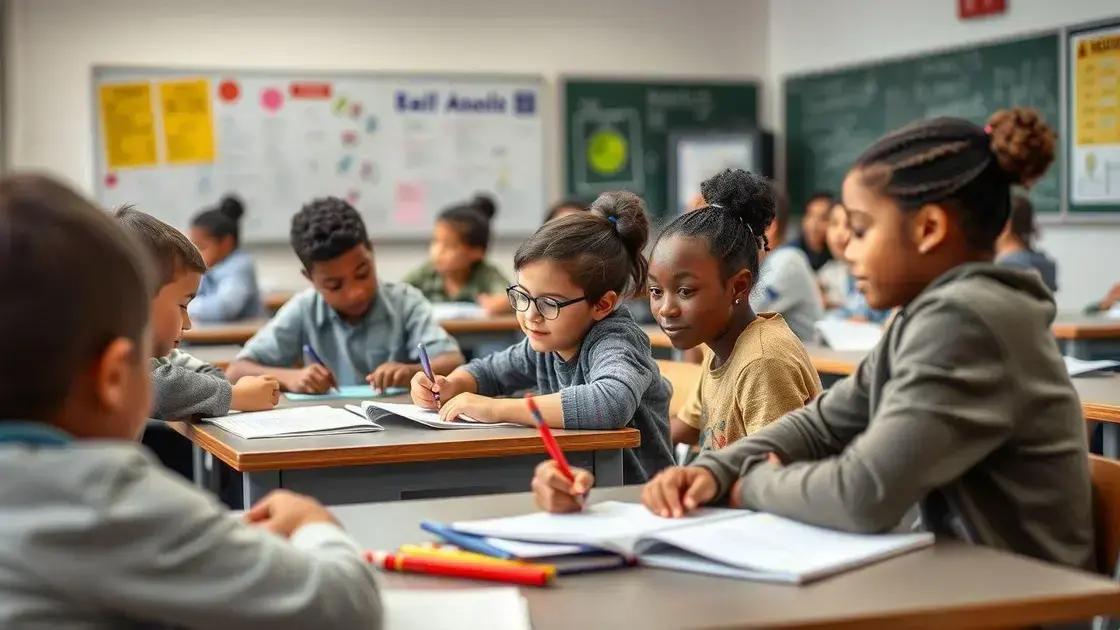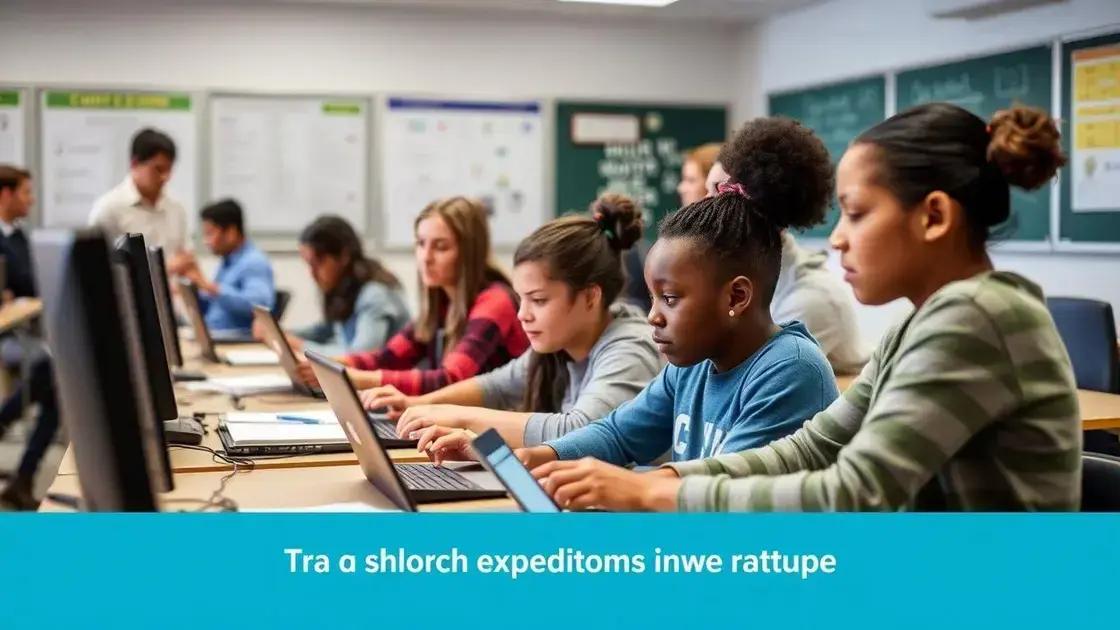Teacher shortages: What you need to know now

Anúncios
Teacher shortages are caused by low salaries, challenging working conditions, and high stress levels, impacting both educators and students negatively unless addressed through community involvement, improved support, and effective recruitment strategies.
Teacher shortages are becoming a major concern in many areas, raising questions about how our educational system can adapt. Have you noticed the impact in your own community? Let’s dive into this critical topic and explore its implications.
Anúncios
Understanding the causes of teacher shortages
Understanding the factors behind teacher shortages is essential to addressing this critical issue. Many regions are struggling to retain educators, and the impacts are felt in classrooms everywhere.
Key Factors Contributing to Teacher Shortages
Several reasons are at the heart of the current teacher shortages. These include low salaries, challenging working conditions, and a lack of support. Each factor plays a significant role in discouraging potential teachers from entering the profession.
Anúncios
- Insufficient pay compared to other professions.
- High levels of stress and burnout.
- Limited resources for classroom management.
- Inadequate professional development opportunities.
Moreover, the growing demand for teachers exacerbates the situation. An increase in student enrollment means that schools need more educators, but they often cannot fill these positions. This cycle creates a strain on existing teachers, who may then choose to leave the profession.
The Role of Education Policies
Education policies can significantly affect teacher recruitment and retention. Policies that prioritize funding for education are crucial in attracting new teachers and keeping them in the field. Additionally, supportive measures such as mentorship programs and improved working conditions can make teaching a more appealing profession.
Many school districts are now exploring alternative certification programs to help address the shortages. These programs allow non-traditional candidates to enter the teaching field, which may help ease some of the gaps. However, it is vital to ensure that these individuals receive adequate training and support.
Ultimately, understanding the causes of teacher shortages is the first step toward finding effective solutions. By tackling the root problems, we can create a more sustainable and healthy environment for teachers and students alike.
Impact of teacher shortages on students
The impact of teacher shortages on students is profound and far-reaching. When there aren’t enough teachers, students can miss out on crucial learning experiences. The quality of education can decline, affecting their overall academic performance.
Effects on Learning Environment
With fewer teachers available, classrooms often become overcrowded. This environment makes it harder for students to focus and engage. Additionally, inadequate teacher support can lead to disruptions, impacting the learning experience.
- Increased student-to-teacher ratios.
- Less individual attention for struggling students.
- Higher dropout rates among students.
- Lower overall student morale and motivation.
Furthermore, a lack of experienced teachers can weaken the curriculum. In many cases, substitute teachers or non-certified educators step in, leading to inconsistencies in teaching quality. Students may find themselves unprepared for exams or standardized tests, impacting their future opportunities.
Socio-Emotional Effects
The emotional well-being of students can also suffer due to teacher shortages. A supportive teacher-student relationship plays a critical role in student development. When there are fewer teachers, students might feel isolated or neglected. This lack of support can lead to increased anxiety and stress.
Building positive relationships in the classroom fosters a sense of belonging. However, teacher shortages make it difficult to establish these connections, affecting students’ attitudes towards school. As a result, some students may become disengaged, leading to behavioral issues and decreased participation.
Addressing the impact of teacher shortages is essential for promoting a healthy educational system. By understanding the effects on students, schools can take proactive measures to improve the situation and ensure a better learning environment.
Exploring solutions to address teacher shortages

Exploring solutions to address teacher shortages is crucial for improving education across the board. As schools struggle to maintain quality instruction, various strategies are emerging that can help bring teachers back to the profession and attract new talent.
Incentives for Retention
One effective strategy is to offer better incentives for current teachers. Increased salaries and benefits can motivate educators to remain in their positions. Additionally, providing bonuses for hard-to-fill roles can help attract teachers to underserved areas.
- Higher base salaries to compete with other professions.
- Sign-on bonuses for new teachers.
- Tuition reimbursement for further education and certifications.
- Improved health benefits to support teachers’ well-being.
Professional development opportunities also play an important role. Schools that invest in their teachers through training and workshops can boost job satisfaction and reduce turnover rates. A supportive work environment encourages teachers to stay in their positions longer.
Community and University Partnerships
Building partnerships with local universities can provide a pathway for future teachers. Programs that allow students to shadow teachers or intern in classrooms can spark interest in education as a career. These initiatives help create a pipeline of new educators who are familiar with the local school culture.
Additionally, community involvement is vital. Engaging parents and local organizations in teacher recruitment efforts can enhance support for educators. When communities actively participate, they create a culture that values education and attracts new teachers.
Overall, discovering solutions to the teacher shortages requires a multifaceted approach. By implementing effective strategies and fostering supportive environments, schools can enhance teacher retention and recruitment, ultimately improving student outcomes.
The role of technology in supporting educators
The role of technology in supporting educators is becoming increasingly important in today’s learning environment. Technology can provide valuable resources that enhance teaching and learning processes. By integrating technology into the classroom, teachers can offer more engaging and interactive lessons.
Enhancing Teaching Tools
Using tools like interactive whiteboards, educational apps, and online resources allows teachers to present information in innovative ways. These tools not only capture students’ attention but also make complex subjects easier to understand.
- Interactive lessons that engage students.
- Access to a vast range of online materials.
- Improved collaboration through digital platforms.
- Personalized learning experiences based on student needs.
Moreover, technology provides opportunities for professional development. Online courses and webinars enable teachers to continuously learn and grow in their profession. This creates a culture where educators feel supported and motivated to improve their teaching skills.
Communication and Collaboration
Another significant benefit of technology is enhanced communication. Tools like email, messaging apps, and learning management systems allow for easy communication between teachers, students, and parents. This fosters a supportive community that contributes to student success.
Through collaborative platforms, teachers can work together to share best practices and resources. This sharing of knowledge helps create a stronger educational environment, where educators can support one another and learn from each other’s experiences.
In conclusion, the role of technology in supporting educators is crucial for promoting effective teaching and learning. By integrating technology into schools, we can not only enhance educational tools but also create a collaborative and engaging atmosphere for students and teachers alike.
Community involvement in teacher recruitment efforts
Community involvement in teacher recruitment efforts plays a significant role in shaping the future of education. When local communities actively participate, they can help attract passionate individuals to the teaching profession.
Building Awareness
One of the key aspects of community involvement is raising awareness about the importance of teaching. Schools can collaborate with community organizations to highlight the benefits of a teaching career. This can include hosting events that showcase teaching as a rewarding and impactful profession.
- Organizing career fairs focused on education.
- Inviting local educators to share their experiences.
- Creating mentorship programs for aspiring teachers.
- Providing information sessions in local high schools.
By engaging students early, communities can inspire the next generation of teachers. These efforts help to create a supportive pipeline that encourages young people to consider teaching as a viable and fulfilling career option.
Partnerships with Local Institutions
Partnerships with local colleges and universities can further enhance recruitment efforts. Collaborating with educator preparation programs allows schools to identify potential candidates who are eager to enter the teaching field. These partnerships can offer internship opportunities for students, giving them valuable classroom experience before graduation.
Moreover, local businesses can contribute by providing resources or funding for scholarships aimed at future educators. Financial support can reduce the burden of education costs, making teaching more accessible for many aspiring teachers.
Ultimately, community involvement in teacher recruitment is essential for addressing shortages and improving the quality of education. By working together, communities can create a strong support system for teachers and future educators, ensuring a brighter future for students.
In conclusion, addressing teacher shortages requires a collective effort from communities, schools, and policymakers. By recognizing the important role of community involvement, exploring technological support, and implementing effective recruitment strategies, we can create a more sustainable and positive environment for teachers and students alike. Solutions like enhancing teacher retention, building strong partnerships, and engaging future educators are essential steps toward ensuring a brighter educational future. Together, we can make a meaningful difference in education.
FAQ – Common Questions about Teacher Shortages
What are the main causes of teacher shortages?
The main causes include low salaries, poor working conditions, and high levels of stress that lead to teacher burnout.
How does community involvement help address teacher shortages?
Community involvement helps raise awareness and attract passionate individuals to the teaching profession through support and recruitment efforts.
What role does technology play in supporting teachers?
Technology enhances teaching methods, provides valuable resources, and offers professional development opportunities for educators.
What strategies can schools implement to retain teachers?
Schools can offer incentives like higher salaries, professional development, and supportive work environments to retain teachers.






